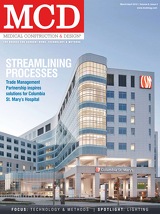Medical Construction & Design (MCD) is the industry's leading source for news and information and reaches all disciplines involved in the healthcare construction and design process. To view more past issues go to: http://mcdmag.epubxpress.com
Page 24 of 70
SPOTLIGHT LIGHTING
products. Zhaga will estab- lish specifi c module types, defi ne dimensions, mount- ing characteristics, thermal and electrical characteristics and photometric distribution. Interchangeability is achieved by defi ning interfaces for a variety of application-specifi c light engines. When an owner purchases a Zhaga-labeled product, it is ensured that
will be able to use the same- sized fi xture to deliver light in 8'-20' ceilings just by chang- ing the module, something that cannot be done with any other light source today. Lighting designers will be able to specify products for long-term, large-scale clients and know when remodeling fi ve or 10 years from now, there is an ability to get the
atmosphere, it is desirable to be able to dim the lights to different levels over the course of the day. Compact fl uorescent lamps have never been particularly satisfactory in this area because even with the best equipment, they turn a blue-like color at the lower end of the dimming range, often fl icker and, even with good color, produce a very fl at light. Some LEDs can be dimmable and they can be driven with a constant current or voltage driver. Drivers and controls must be compatible and selected to- gether. However, sometimes are as simple as standard incandescent dimmers and controls. In many instances, dimming does not add to the cost of the LED product.
LEDs are largely replacing compact fl uorescent fi xtures because of lower energy use and longer life. Low- or no-cost dimming and longer warranties are additional advantages.
the parts are replaceable and interchangeable between manufacturers, much as lamps are today. With a Zhaga module,
fi xture manufacturers can go back to the primary focus and work on the best way to deliver light from fi xtures. They will not be dependent on a single source for core product element and can potentially supply a range of outputs from a single piece of hardware. With Zhaga prod- ucts, industry stakeholders
latest version of the product. If the desire to upgrade exist- ing products arises, it is a job the maintenance staff can do. It also allows comparison be- tween two manufactures on an apples-to-apples basis. Three things that have been very attractive to designers about LEDs is the potential for good color, dim ability and small size. The word "potential" is key be- cause these features are not inherent in LEDs. When trying to create a hospitality-like
20 Medical Construction & Design | March/April 2012
Visually speaking Good color is possible, but not a given, so this may be the area where a visual test is the most critical. During informal testing, a wide varia- tion in the color quality of products that are labeled with the same color temperature and CRI has been seen. The only solution to this is to visu- ally test every product before purchasing it. There is talk in the industry of moving to a different standard to defi ne the color of an LED source but until then, visual inspec- tion is the only option. It has also been noticed that sometimes when LEDs on paper look to be about the same or slightly lower output than the CFL coun- terparts when installed, they
appear brighter. This could be caused by the higher blue content in the light source (even in the warm versions), multiple sources combining to create a more textured, less fl at light or some other element yet to be defi ned. Having a dimmer control in these situations has been very desirable. The fi nal benefi t to LEDs is the extended warranties. Most manufacturers offer three- or fi ve-year warranties on the electronics and some offer up to 10 years. This is a signifi cant increase over conventional products, which have a one-year warranty. The cost of a dimmable
LED fi xture today is roughly equivalent to a dimmable CFL product. For healthcare institutions looking at long- term goals to create hospi- tality-like, high-quality visual environments, provide fl ex- ibility, minimize frequency of maintenance, reduce energy use and reduce mercury in facilities, LEDs are the answer.
Denise Fong, IALD, LEED AP, MIES is a principal and light- ing design practice leader for Candela. She has more than 30 years of experience in specialized lighting design for healthcare clients. Recognized by profes- sional peers with numerous design achievement awards, she is highly skilled in assisting in developing high-quality, energy- effi cient lighting systems for in- terior and exterior environments. She can be reached at dfong@ candela.com.
Editor's Note: For more information on Zhaga, visit www.zhagastandard.org.
www.mcdmag.com
PHOTO: ECKERT & ECKERT
